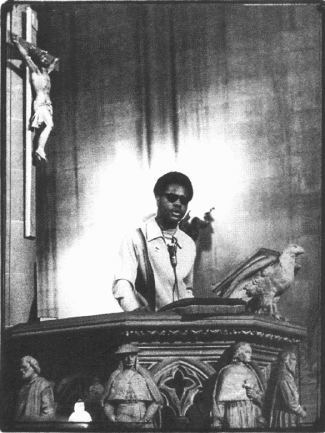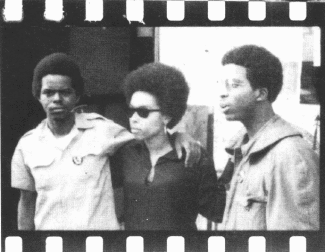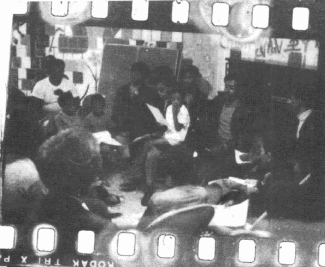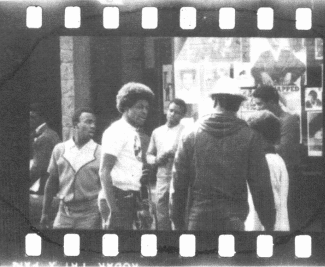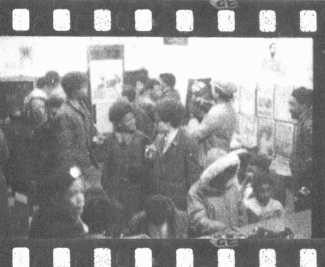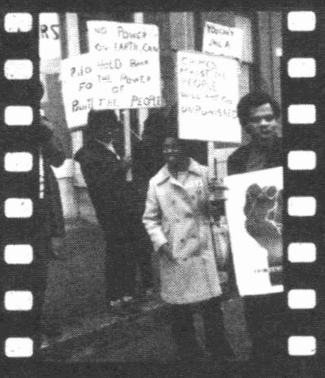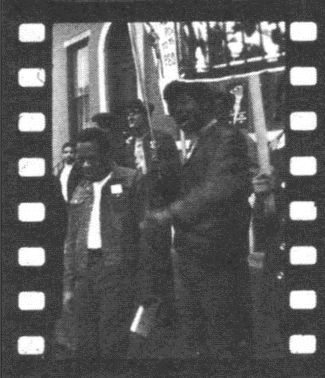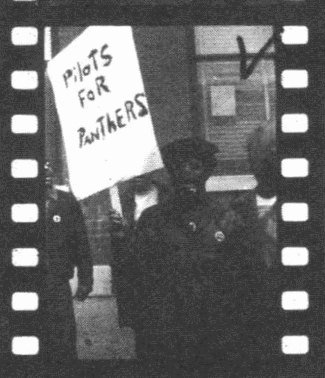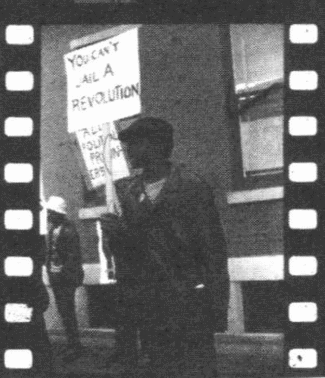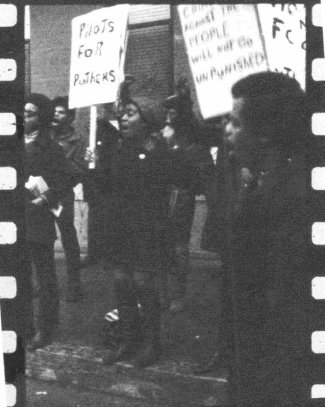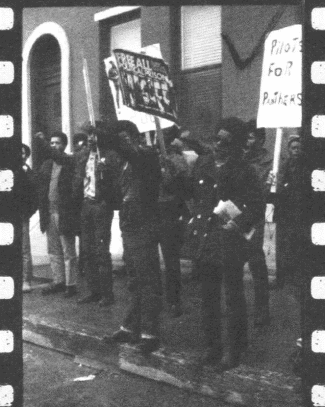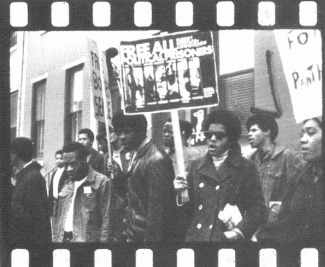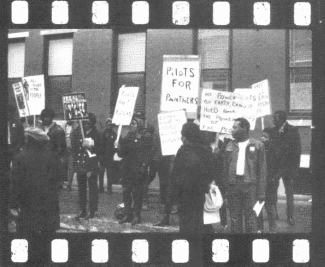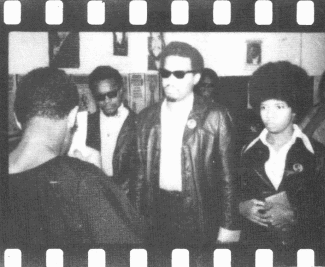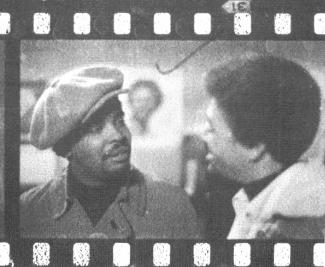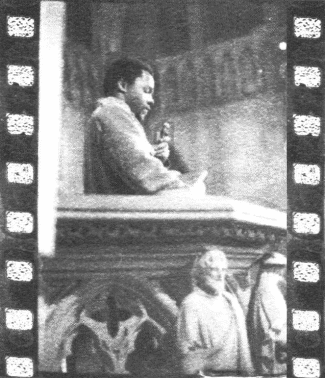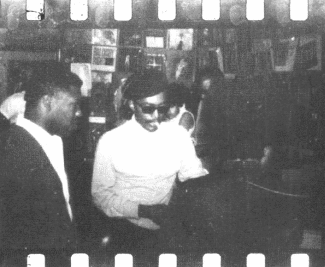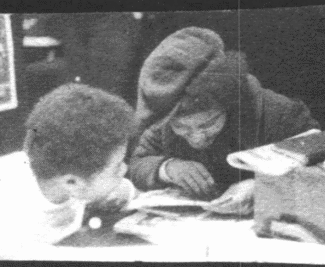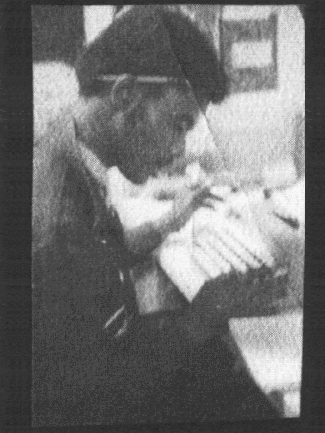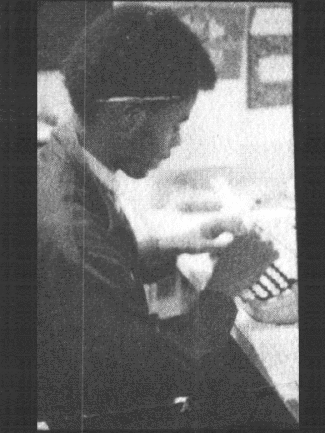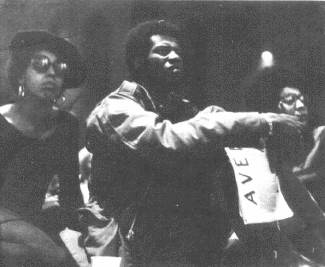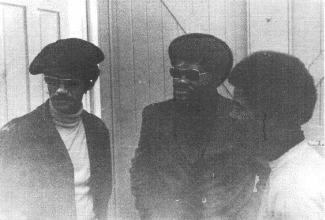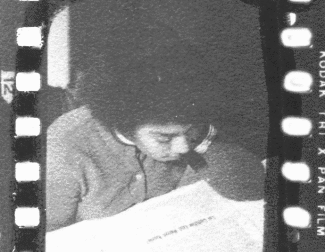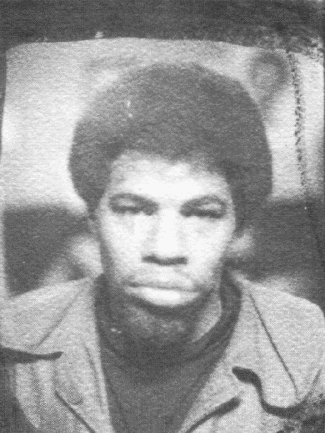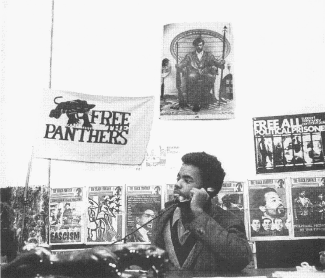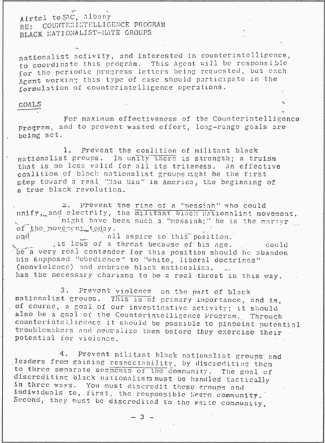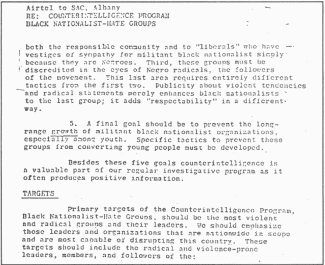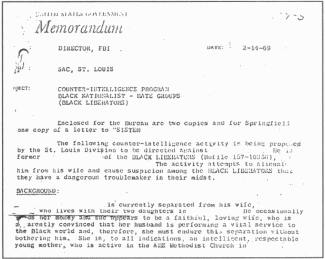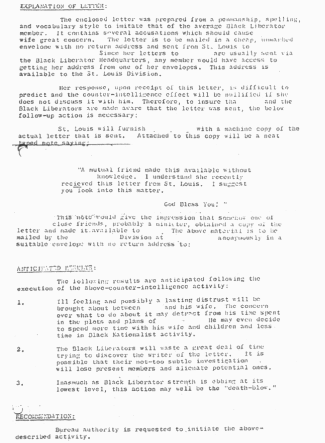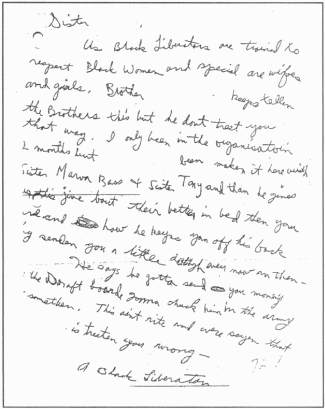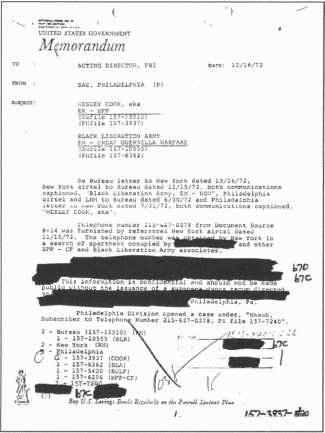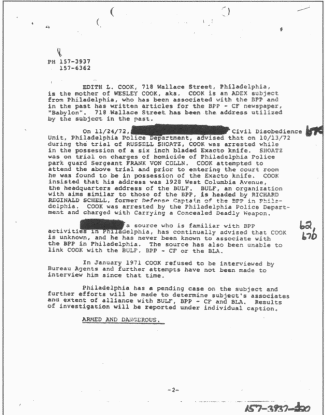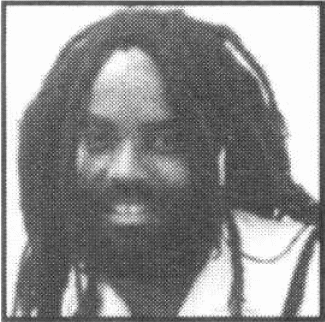There is a tide in the affairs of men Which, taken at the flood, leads on to fortune; Omitted, all the voyage of their life Is bound in shallows and in miseries.
On such a full sea are we now afloat, And we must take the current when it serves, Or lose our ventures.
-- William Shakespeare, Julius Caesar (Brutus to Cassius)
TO MANY BLACK and white radical youth of today, the very existence of the Black Panther Party seems almost miraculous. To many of the young people who worked, lived, and loved in the Party, however, the Party was not a miracle, but a bright, shining reality, one born of radical necessity.
It was the stuff of bitter hopes, of frustrated dreams, a will-o'- the-wisp of Black desires that caught on the wind's ragged updrafts, and spread like a fire in the mind, across vast distances.
In the years preceding the birth of the Party, famed Black labor leader and 1963 March on Washington organizer Bayard Rustin would argue that southern Blacks had no intention of leaving their traditional, albeit troubled, home in the Democratic Party:
Southern Negroes, despite exhortations from S CC to organize themselves into a Black Panther Party, are going to stay in the Democratic Party -- to them it is the party of progress, the New Deal, the New Frontier, and the Great Society -- and they are right to stay. [1]
For the most part, of course, Rustin's insight has stood the test of time; however, within months of his writing, there was indeed a Black Panther Party with Blacks as fervent members in the North, the South, the West, and the East. All were united under the inspiring vision of Huey P. Newton and by Malcolm's post- NOI powerful exhortations to revolution.
With the whole world seemingly embroiled in revolutionary and anticolonial struggle, and given the oppressive nature of Black existence, it seemed not only logical but inevitable that Blacks in America would launch mass movements of rebellion. The Black Panther Party, as the embodiment of that rebelliousness, seemed as natural as rain showers in April.
Within a decade of its flowering however, the split dealt a serious blow to the BPP. For a time, like jealous, bickering twins vying for a prince's throne, the two sides were locked in conflict; each strove to prove it was the legitimate heir to the name of the Black Panther Party.
Newton, ever the Nietzschean, sought to actuate his own will to power, sought to minimize the damage by denying the very existence of a split. He termed it a "ghost split" that was more media creation than material reality. [2] In a sense, he was correct. Broadly speaking, however, he was not.
For there can be no question that the antagonistic media delighted in projecting and exacerbating any hint of conflict between members and even supporters of the Black Panther Party.
Yet, there was a split.
Cleaver, raging and fuming in Algiers, announced he would lead the "real Black Panther Party" from his redoubt in North Africa. Newton would dismiss him as "an ultraleft sorcerer's apprentice with a gift of verbal magic." [3]
Truth be told, the bulk of the organization remained firmly in Newton's grasp. Newton also held on to the Party's crown jewel, The Black Panther newspaper. The paper was valuable, not merely because of the financial resources it generated, but because it directly communicated with hundreds of thousands of people, weekly, unmediated by the establishment media.
Yet, by mid 1971, it became clear that some who resigned from the organization resigned from its western branch and affiliated with the wing of the East Coast Black Panther Party, headquartered in Harlem and the Bronx. Panthers in the East published Right On! Black Community News Service, a Black Panther newspaper in everything but name.
Like any divorce, parting was not sweet sorrow.
Panthers, feeling either deeply wounded or deeply betrayed, turned their volcanic anger, their frustrated rage, and their misguided vengeance on each other, with predictably disastrous results. Selling a newspaper, whether East or West, became a serious matter. Indeed, walking the streets became problematic, as shown by the noted killing of the diminutive Robert Webb and echoed by the killing of Sam Napier. They were but part of half a score of Panthers who appeared to have met their ends at the hands of other Panthers.
The fate of Webb and others like him showed that the split was far more than Newton's "ghost split."
This was a split of the spirit.
There was, in fact, more than one split; there were several. In each, a new organ came into being to give voice to the alienation that arose between former comrades. As Right On! marked the emergence of the East Coast Black Panther Party, a new journal, Babylon! Revolutionary People's Communication Network, reflected the emergence of a formation to the left of the East Coast Party, more in line with Cleaver's exhortations to present a more radical, more militant, and more confrontational profile.
But, as Safiya Bukhari recalls, Cleaver's influence, at least in the East Coast, New York-based formation, had its limits. She recalls receiving an unexpected transatlantic phone call that broke into a tense, nerve-wracking night:
This particular night I was on security at the Harlem office, along with two other people when the phone rang. When I answered the phone an operator said, Your overseas party is on the line. Go ahead please. I said I didn't make an overseas call. I didn't make one but Eldridge Cleaver was on the line from Algeria. either one of us had placed the call, but we knew who had. It seems the government or somebody wanted us to talk about something.
We decided to talk despite not initiating the call. Eldridge took the opportunity to tell me that it was time to escalate the struggle. He said it was time to take it to the streets and that's what I should tell people to do. I said, NO! I was not going to tell people to do that. I told Eldridge that the conditions were not right and I was not going to encourage our people to go out and take part in or become victims of a bloodbath. I held firm because I truly believed I was right. Eldridge didn't know the objective conditions here. He was over 3,000 miles away, in Algeria.
When he saw he was getting nowhere with me he put Cetawayo [Michael Tabor, one of the Panther 21, who fled to Algiers rather than face trial or reprisal] on the phone. Cet told me I should do as Eldridge requested. I asked, Cet, do you remember what you taught me? To deal with the principle and not the personality? Cet said in that deep, deep, melodious voice, that he possessed, Yes. He was silent for a moment and then made no further attempt to get me to do what Eldridge wished. [4]
Although Bukhari felt tremendously empowered by her stand off with the influential and charismatic information minister, Cleaver's voice remained the dominant one heard through the East Coast's main organs, Right On! and Babylon! These papers documented the growing splits and countersplits severing the Party. To the people not intimately involved with the various feuding factions this was but a recipe for confusion and did not serve any faction well.
It served the interests of the State.
The second split, marked by the journal Babylon!, meant far more than a third Black revolutionary paper. It meant, for some, their final leave from the party of their dreams and hopes and the leap into the uncertainty of small, revolutionary collectives like the clandestine Black Liberation Army, unaffiliated with known, above-ground radical organizations.
From his penthouse in Alameda County, Newton would decry the revolutionary cultism of the early Black Panther days and, by clear implication, criticize Cleaver for what Newton termed his defection from the Party and, more importantly, the Party's defection from the very people it was sworn to defend and serve:
[A]nything said or done by a revolutionist that does not spur or give the forward thrust to the process (of revolution) is wrong. Remember that the people are the makers of history, the people make everything in their society. They are the architects of the society and if you don't spur them on, then I don't care what phrases you use or whether they are political or religious, you cannot be classified as being relevant to that process. If you know you're wrong and do certain things anyway, then you're reactionary because you're very guilty.
... [T]he revolutionary cultists use words of social change; he uses words about being interested in the development of society. He uses that terminology, you see; but his actions are so far divorced from the process of revolution and organizing the community that he is living in a fantasy world. So we talk to each other on the campuses, or we talk to each other in the secrecy of night, concentrating on weapons, thinking these things will produce change without the people themselves. Of course people do dangerous things and call themselves the vanguard, but the people who do things like that are either heroes or criminals. They are not the vanguard because the vanguard means spearhead, and the spearhead has to spear something. If nothing is behind it, then it is divorced from the masses and is not the vanguard. [5]
As Newton's remarks suggest, the Black Panther Party, like any living, sentient organism, changed, developed, and transformed itself over time. Indeed, even before the split in its very insular, organizational history, it was "one, two, many parties."
As we have seen, at its inception under the name of the Black Panther Party for Self-Defense, the Party was deeply nationalist and was influenced by the ideas of the late Malcolm X. Shortly thereafter, the dropping of the "for Self-Defense" from the group's name signified the broadening of the Party's vision, and it began to view itself as a "revolutionary nationalist" formation and opposed the cultural nationalism of groups like the US organization. [6]
During this period, the Party's internal organization took the form of revolutionary cultism. Inspired by the explosion of national liberation movements and armed revolutions in the 1960s, the model of the revolutionary foco, a relatively small group of men (and occasionally women) staging antistate, or anticolonial actions, had tremendous appeal to young African American revolutionaries who, like all Americans, were notoriously impatient. Newton condemned this period for its concentration on weapons and revolutionary dialogue; for ignoring the hard necessity of popular organizing. [7]
As members studied the struggles raging around the world, they saw so many similarities between those waged internationally and domestically that solidarity with the world's people seemed only logical. The Party used the term intercommunalism to describe this development. This term referred to the interaction of global communities and was based in Newton's analysis that US imperialism precluded nationhood and recognized that independent nations couldn't exist.
The Party, reeling from repression and accumulated death and loss, ended its days operating in a reformist/electoral mode that left it isolated from its core community as it focused its efforts on the mayoral campaign of Bobby Seale and the City Council campaign of Elaine Brown.
The year 1982 marks the official death of the Black Panther Party, since that was when many of the Party's programs, like the once-acclaimed Intercommunal Youth Institute (or primary school), and the publication of the BPP newspaper ceased, though, for many, it had died years before.
At each phase, the Party evolved (or devolved) into something quite distinct from what it had been before. The Party, like the proverbial cat, had many lives. At some phases of its life, it ran with grace and purpose, at others, it limped, wounded by external and self-inflicted injuries.
That it survived and functioned at all, in the face of the State's overt and covert repression, especially for the extended period that it did, is a startling testament to the vision of its founders and the gritty will of its membership.
After the Party?
Organizations such as the Black Panther Party, which have appreciable impacts on community consciousness and political development, do not simply fade into the ether. Throughout African American history, we have seen the demise of one group presage the rise and development of another. The quasi-nationalist Moorish Science Temple movement of the 1930s gave rise to the Nation of Islam and other Black Muslim movements.
Similarly, the Black Panther Party's formal and informal demise as a national revolutionary entity gave rise to a number of localized radical and revolutionary formations. Many of these successor groupings were led by former members of the BPP and sought to recreate the spark of the Party along local, regional, or coastal lines.
In Philadelphia, ex-BPP cadre formed the Black United Liberation Front (BULF), which worked on police brutality issues and ran "a free breakfast for children program, a free clothing program, a bus ... to take people to visit relatives and friends in prison .... [It] organized all the gangs on this side of Broad Street at one point in 1971-72 and got them instead of fighting each other, to start turning over abandoned cars, throwing trash and garbage that the city wouldn't collect, and blocking up the street demanding that the city turn over abandoned houses in the Black community ... " [8] Within a decade, through declining membership and lack of resources, BULF was largely defunct. In Kansas City, Missouri, a militant, aggressive cadre of ex-BPP personnel transformed their chapter into a group called the Sons of Malcolm. They, too, after several years, ceased to exist.
While the African People's Socialist Party (APSP) was more a contemporary competitor than a successor, the St. Petersburg, Florida- based nationalist organization utilized ex-BPP talent like Akua Njeri (nee Deborah Johnson) to preside over the APSP-led National People's Democratic Uhuru Movement. Njeri was the fiancee of Fred Hampton, and narrowly escaped death in the government attack that left Hampton dead. In addition to using key ex-Panthers in their APSP apparatus, the organization created propaganda that made frequent references to BPP personnel. Njeri has spoken of her current political role as a "continuation of the Panther legacy." [9]
What began in 1990 as the New Black Panther Party (NBPP) in Dallas, Texas, took root from a call by Michael McGee, a city councillor and former Panther, for the establishment and arming of what he termed the Black Panther Militia of Milwaukee, Wisconsin. McGee's 1990 talk show appearance in Dallas would inspire radio producer Aaron Michaels to launch a local chapter.
Although there are indications that the Dallas group initially began community programs, notably a breakfast program,1O by 1991, when the NBPP name was formally registered, Michaels seemed to have soured on this idea. He is quoted opining, "Survival programs are good, but they don't make us free." [11]
This suggests the NBPP has traveled some distance from its namesake. The rise of Dr. Khallid Abdul Muhammad, the former NOI national spokesman, to the group's leadership perhaps best marks the change. While Michaels took the rank of Defense Minister, Dr. Muhammad, with his penchant for angry, anti-white and anti-Jewish speech, emerged as de facto leader of the NBPP until his sudden death, due to a brain aneurism, on February 17, 2001.
His successor, the Howard University-trained attorney, Malik Zulu Shabazz, has tried to emulate Muhammad in style and speech. Under Shabazz, the NBPP sounds themes that sound closer to NOI ideology than to the original BPP. When David Hilliard critiqued the NBPP for having "totally abandoned our survival programs," Shabazz claimed that the original BPP "are really working with the Zionists," [12] and suggested that they may be engaged in counterintelligence for the FBI.
That Shabazz could suggest that the "originals" were somehow "Zionist" supporters reflects the dearth of study engaged in by the NBPP on those whose name they now bear. It was the original BPP who announced that "Zionism=Racism" and took the largely unique stance among Black nationalist-oriented groups of the era in support of Palestinian liberation.
In the NBPP Newton's writings are rarely, if ever, read, and although its imagery and uniform may have been adopted-few original ideas have been. The NBPP seems to be an emergence of the NOI under a different name.
In 1994, the New African American Vanguard Movement (NAAVM) emerged in Los Angeles, California. The organization was founded by, and its collective leadership was partly composed of, former members of the original BPP. The group formulated an eight-point platform and program as an updated version of the original 10-Point Program. [13]
This group has continued to develop, changing its name to the New Panther Vanguard Movement (NPVM), expanding the original eight points to its present ten, and publishing a newspaper that bears a striking similarity to the original Panther newspaper. According to a recent edition of the NPVM quarterly, NPVM collectives are active in Indianapolis, Indiana, and Decatur, Georgia.
In New York City, a group partly composed of former BPP people formed the Black Panther Collective (EPC) in 1994. They have described their objectives thusly:
(1) to continue the revolutionary legacy of the Black Panther Party; (2) to put forth a vision of a new and just society; (3) to build a revolutionary infrastructure; and (4) to engage in protracted revolutionary struggle. [14]
In language at least, the BPC's objectives can hardly be distinguished from the early Party.
Anarchist organizations are also looking to the Black Panther Party as they formulate their positions. Ashanti Alston, a former member of the BPP and the BLA, and a political prisoner for over twelve years, publishes the magazine Anarchist Panther and was active in organizing the Anarchist People of Color conference. Revolutionary Active Communities Uprising in Numbers (RACUN) developed a version of a ten-point plan and is developing survival programs and a self-defense program.
Such groups as these demonstrate the wish to utilize the original BPP as a potent symbol of radical social change. They continue to look to the Party's remarkable example for sustenance and as a source of strength for the struggles yet to come.
In that sense, it may be said that the Party continues to exist-if only in the hearts and minds of many.
Legacies
There are many legacies of the Black Panther Party. They are, as all else in life, both positive and negative and vary depending upon where one looks for them.
What remains in Black youth consciousness (and youth consciousness in general) is the Black Panther Party as a symbol of resistance. The image and ideas of the Black Panther Party, and Huey P. Newton, still attract interest and attention. This may be traced to the frequent mention of the Black Panthers in hip hop. The relative success of the 1994 film Panther, by popular Black filmmakers and actors Mario and Melvin Van Peebles, while hardly a blockbuster, became for many young people their eye-opening introduction to an aspect of Black contemporary history they were never told about in school.
Another measure of the continuing vitality of the Black Panther Party in Black consciousness may be seen in the continued publication of the writings of Panthers. Recently Seven Stories Press released a compilation of Newton's writings, as The Huey P. Newton Reader. Black Classics Press has reissued Bobby Seale's Seize the Time and George Jackson's Blood in My Eye. Philip Foner's The Black Panthers Speak has also recently been reissued, and Assata Shakur's autobiography Assata and Elaine Brown's A Taste if Power remain popular.
Of course, it would be disingenuous to ignore some other legacies, even if they are negative ones. Forrest Gump, a somewhat more successful film venture than Panther, starred Tom Hanks as a mentally challenged individual who makes improbable friends with people, with unforeseen historical effects. In order to lend the film a sense of authenticity reflective of the period of social upheaval, the Hanks character encounters a uniformed Panther figure who is so overcome with rage that what he says sounds like barely intelligible nonsense. The clear inference of the movie is that the Panthers largely spoke incoherently to people. It also perpetuated the impression of the BPP as an armed group of outlaws. The two film treatments demonstrate that the legacy and meaning of the Black Panther Party continues to be a conflicted one.
This is not only so in the realm of American popular culture, but in an area that impacts African American life in dozens of ghettos and inner cities every day.
Urban gangs have become a national phenomenon since the passing of the BPP. This was not unforeseen as former BPP political prisoner Geronimo ji-Jaga told a German reporter in 1993:
Huey Newton gave a lecture on that one time and we had foreseen that this was gonna happen. After the leadership of the BPP was attacked at the end of the '60s and the early '70s, throughout the Black and other oppressed communities, the role models for up-coming generations became the pimps, the drug dealers, etc. This is what the government wanted to happen. The next result was that the gangs were being formed, coming together with a gangster mentality, as opposed to the revolutionary progressive mentality we would have given them. [15]
Given this ruinous social dynamic, it is telling that even under these conditions the ethos of the BPP, perhaps through remnants of the organization or perhaps through the power of example, seemed to seep into the origins of the notorious Crips and the Bloods.
This influence may be seen in the gangs' names. CRIP originally stood for Community Resource Independent Project. [16] Their adversaries were originally Brotherly Love Overrides Oppression Daily (BLOOD). [17] The former Crip turned New Afrikan nationalist Shaka Sankofa (formerly "Monster" Kody Scott) cites prison sources for an attempted reorganization of Crips under the name Clandestine Revolutionary Internationalist Party Soldiers. [18]
Clearly, at some level, the rhetoric of the BPP has resonance in the psyches of the originators and reorganizers of Black youth gangs. That it did not go further may be ascribed to the loss of a living model.
Public Service
To a generation living in an era of market ascendancy and cultural commodification, one lesson the Party teaches is the importance of public service as an organizing focus. The Party stood for social service to one's community that was unremunerated and one's collective, communal duty. Integral to this idea was the secular mission of the Party to reclaim and redeem Black men who were engaged in antisocial, lumpen-type criminal activities.
The very process of politicization served to provide members an analytical framework through which they could perceive the function of the State, and its "security" apparatus, as a protector not of the people, but of a privileged class. It also illuminated how the acts of petty, antisocial criminals contributed to the continued powerlessness and political subordination of their communities. While the Party did not actively promote the redemptive side of itself, the lived experiences of members were telling reflections of a deeply held and socially acceptable conversion experience, not to a religion, but to a political perspective. Shaba Om (ne Lee Roper) recalled reading an issue of Ramparts magazine that featured an article on the Black Panther Party. The article impressed him so much that he began searching for members of the BPP in Harlem. When a member provided him with a copy of The Black Panther, he found himself deeply moved and deeply motivated to renounce and distance himself from his criminal past. This tactic was also a popular organizing strategy of the Nation of Islam and was a well-known element in the transformation of Malcolm X. Om recalls:
I began to go to political education classes -- but I was still hung up on the bag of pimping. What really got me out of that madness was political education, me digging on my true self as a black man, and the Honorable John Coltrane's music. I dug what I was doing to my people and myself. In 1968, I had got myself together and stopped jiving. Began to go to political education classes every night after slave. After political education classes, I would go to my pad and try to hide from the jive niggers I knew.
It was past time for me to come forward and correct the wrong I'd done. I knew all the madness I was doing on the streets was wrong as two right shoes, dig.... [T]he only thing left was to become a true helper and servant of my beautiful people .... This is when I really became a Black Panther, warrior of my people. [19]
This can only be seen as a profound conversion experience -- a redefinition of the self, one's true self; one's becoming. What pushed Om and others across the divide, from a life of crime to a life of service and sacrifice, was personal tragedy, a shattering event that forced one to confront one's place in the world, especially one's racial identity, and one's political place in the universe. [20] Om, and many young people like him, was undergoing a profound psychological metamorphosis; the cracking of the egg of the old self, and the emergence of the new. To Om, as a pimp, drug pusher, and user, death became the doorway to this new life:
And this sister I was relating to as my main love died from skag. Man ... like this blew my mind, because she had quit skag once, and come to me for help because she dug me and my way of thinking-and I turned my back on her; this really blew my mind when she died. I was going to political education classes then, too, when she died. The first thing that came into my mind was, I helped the pigs kill one of my sisters. [21]
Love and loss brought him to the Black Panther Party and compelled him to find his better self -- a servant of the people, rather than as a predator against the people.
Many former Panthers continue the legacy of social service by including those working as drug counselors, antigang coordinators, and teachers. Former Panther and the Illinois Deputy Minister of Defense Bobby Rush serves in the nation's House of Representatives.
Women of the Party
Many female Panthers ,vent on to lead or staff community organizations and social help groups. Some have become scholars. Some have become lawyers. Some, like Kathleen Neal Cleaver, have merged both practices into one. Cleaver, a law professor, has worked on cases such as the infamous frame-up of former political prisoner Geronimo ji-Jaga. Joan Gibbs, a former political prisoner, has worked for years as a legal scholar, activist, and administrator at Medgar Evers College in Brooklyn, New York.
The Black Panther Party was a distinct training ground for young radical women and instilled in many a certain "can do" attitude that has transcended their years of service in the BPP. Their experiences in the Party prepared them for lives of activism and service. Joan Kelly (now Joan Kelly Williams), who headed the LA chapter's Free Breakfast Program for a time reports:
It's hard to describe what I did. I think all of us did so many different things. When I was in Los Angeles ... your focus could change daily. "So and so is in jail, you've got to run the Breakfast Program." ... men did do program work, I think that's the other illusion that people have is that we had a paramilitary underground and went off and offed pigs at night and the women got up and served breakfast and helped care for people. It is a little more comprehensive than that [audience and panelist laugh]. So, I remember somebody went to jail and I got responsibility in LA for the Breakfast Programs .... The clearest thing we could do was our programs. And if [the police] could keep enough people who serve breakfast in jail in the morning, and the kids got there and there was nobody serving breakfast, then the media could go on the 7 o'clock news and say, That Panther Breakfast Program doesn't work, it's all a fluke. Or whatever, or hoax. So we became very sophisticated. We could come back at you real quick in terms of strategies and ways to meet the challenges that we faced .... The conditions thrust women into roles of leadership early. [22]
Women like Kelly Williams functioned, from sheer necessity, as captains, field secretaries, section leaders, lieutenants, communications officers, and, with Elaine Brown's ascension after the self-imposed exile of Newton in 1974, as head of the entire organization. No other radical or revolutionary formation of that period could boast of such a pronounced range of female prominence.
This depth of revolutionary activist experience and leadership equipped a generation of women with a kind of palpable knowledge; informed and steeled a cadre of women; and prepared them well for the tasks that lay ahead. For example, the revered former political prisoner Ericka Huggins, who supervised the Intercommunal Youth Institute for nearly a decade, continues to work in the field of education as a professor at San Francisco State University and other institutions. She also works with HIV-exposed persons in her community. JoNina Abron, who was an editor of The Black Panther, later became managing editor of The Black Scholar, and is a tenured English professor at Western Michigan University. Regina B. Jennings, who was with the Oakland and Philadelphia branches, earned a doctorate in African American studies and now teaches at Franklin and Marshall College. [23]
Safiya A. Bukhari, a licensed paralegal, worked on behalf of ex-BPP political prisoners until her death in 2003. Kiilu Nyasha of the New Haven chapter is a brilliant artist who addresses political and cultural themes and hosts a popular radio program on Black and radical politics in San Francisco. Rosemari Mealy, who worked in the Philadelphia and New Haven branches, now works as a broadcaster on public radio and has earned her law degree. Rita Gaye Sisk of the Philadelphia branch is a prominent member of the Temple of the Black Messiah in Philadelphia. Cleo Silvers who was with the New York chapter and Young Lords Party is a community organizer and labor activist, who, like Bukhari, has done work on behalf of Black political prisoners. She is a member of the United Auto Workers (UAW) and is active in the League of Revolutionary Black Workers. She also co-chairs the Health Revolutionary Unity Movement (HRUM) and heads the Peace and Justice Anti-War Caucus of New York Local 1199C.
These women, and many unknown soldiers like them, the local Party defunct or in shambles, went back to their homes or adopted communities and continued to serve the needs of the people. They remain remarkable legacies of the Party.
International Impacts and Inspirations
Because the BPP inspired so much media coverage, it assumed an international profile that sparked imitators and admirers around the world. Political scientists Charles E. Jones and Judson L. Jeffries have examined the Party's impressive global reach:
The impact of the BPP transcended the borders of the United States. Panther activities served as a revolutionary exemplar for various oppressed indigenous groups in several foreign countries. Left-wing political formations in England (Black Panther Movement), Israel (Black Panther Party of Israel), Bermuda (Black Beret Cadre), Australia (Black Panther Party), and India (Dalit Panthers) drew from the organization founded by Huey P. Newton and Bobby Seale in the United States. Members of the Black Beret Cadre formed in Bermuda in 1969 adopted the Panthers' signature black beret and sponsored liberation schools and political education classes. Similarly, the Black Panther Party of Israel created by Jews of Moroccan descent in 1971 implemented community services for the children in the slums of West Jerusalem. [24]
That so many radical and nationalist-type groups could borrow the imagery, name, and format of the BPP bespeaks the power and potency of the original organization. While few of these overseas groups had formal organizational ties to BPP headquarters in Oakland, California, by their very existence they helped project the Party's image and message of militant resistance and community service to the poor and oppressed deep into international consciousness. The BPP, perhaps proving the veracity of the old adage that imitation is the sincerest form of flattery, had a global impact that moved radicals, nationalists, and revolutionaries worldwide to emulate some of their more positive attributes.
From Losers to Legends
If there is one unavoidable historical truth about the Black Panther Party, it is this: it lost its long battle for institutionalization and the primary realization of its revolutionary political objectives. It did not establish Black revolutionary power, due to reasons both internal and external.
That said, it experienced a somewhat curious transformation over the course of time, from loser into legend. The very existence of the Party seems to strengthen those who learn of it for the first time. This introduction usually comes not through popular sources of indoctrination -- schools and parents -- but through one's own effort.
This transformation has historical precedent. Consider the case of the Pan-Indian warrior Tecumseh. History concluded that the Shawnee warrior lost, and lost decisively, to the American "Long Knives." Of that, there can be little question. It is also true to say that he is remembered and respected today for the purity of his vision and his attempt to protect traditional, indigenous lands from Western, white domination. His lost struggle was against white lebensraum. Tecumseh and his valiant struggle have joined the annals of legend for generations of Native American, African American, and, indeed, American youth.
As evidence of the transcendence of Native American resistance and how it often finds home in the souls of Black folk, one need look no further than the late but explosively popular rap artist Tupac Shakur. The son of Afeni Shakur, a Black Panther and a veteran of the Panther 21, Tupac was named for an Amerindian warrior who fought against the Spanish colonizers of Peru, Tupac Amaru. A son of a Panther, he was born to let millions know of the unfairness and indignity of the life of his people, and he did so, with great talent and boundless passion.
Before his birth, his pregnant mother was esconced in the city jail called the Tombs. As she awaited a trial that could send her to prison for decades, she composed a gentle, heartfelt letter to her family. I do not know if Tupac ever got around to reading it. But a teenaged Panther in New York on loan from Philadelphia read it, and it made his heart weep with its beauty, its love, and its profound courage. Afeni Shakur wrote:
A Letter to Jamala, Lil Afeni, Sekwiya, and the unborn baby (babies) within my womb.
First let me tell you that this book [a collective autobiography of the Panther 21] was not my idea at all (as a matter of fact I was hardly cooperative). But I suppose one day you're going to wonder about all this mess that's been going on now and I just had to make sure you understood a few things.
I've learned a lot in two years about being a woman and it's for this reason that I want to talk to you. Joan [Bird -- another Panther 21 captive] and I, and all the brothers in jail, are caught up in this funny situation where everyone seems to be attacking everyone else and we're sort of in the middle looking dumb. I've seen a lot of people I knew and loved die in the past year or so and it's really been a struggle to remain unbitter.
February 8th when Joan and I came back to jail I was full of distrust, disappointment and disillusionment. But now the edges are rounded off a bit and I think I can understand why some things happened. I don't like most of it, but I do understand. I've discovered what I should have known a long time ago -- that change has to begin within ourselves -- whether there is a revolution today or tomorrow -- we still must face the problem of purging ourselves of the larceny that we have all inherited. I hope we do not pass it on to you because you are our only hope.
You must weigh our actions and decide for yourselves what was good and what was bad. It is obvious that somewhere we failed but I know it will not -- it cannot end here. There is too much evilness left. I cannot get rid of my dream of peace and harmony. It is for that dream that most of us have fought -- some bravely, some as cowards, some as heroes, and some as plain old crooks. Forgive us our mistakes because mostly they were mistakes which were made out of blind ignorance (sometimes arrogance). Judge us with empathy for we were (are) idealists and sometimes we're young and foolish.
I do not regret any of it -- for it taught me to be something that some people will never learn -- for the first time in my life I feel like a woman -- beaten, battered and scarred maybe, but isn't that what wisdom is truly made of. Help me to continue to learn -- only this time with a bit more grace for I am a poor example for anyone to follow because I have deviated from the revolutionary principles which I know to be correct. I wish you love.
Afeni Shakur (Mar. 20, 1971) [25]
There are, indeed, many legacies of the Black Panther Party. Perhaps the best of them are expressed in Afeni's letter to her unborn child: hope, empathy, knowledge of our imperfections, knowledge of our shortcomings, the continued will to resist -- and love.

